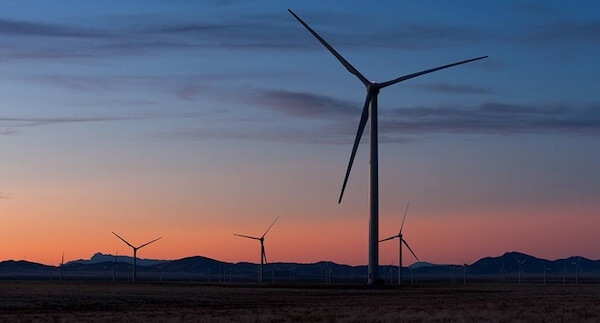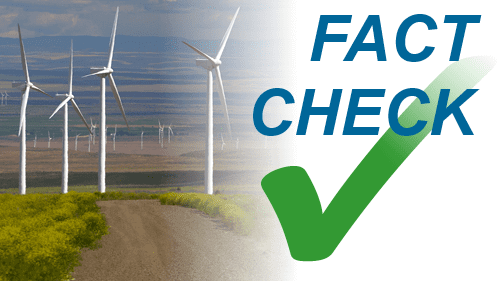Fact check: Fossil-funded think tank strikes out on cost of wind
After two failed attempts to attack wind energy earlier this month, the fossil-fuel-funded Institute for Energy Research (IER) has now struck out swinging (strikes one and two are documented here). Strike three comes from a report written by Michael Giberson that relies on obsolete data and largely regurgitates anti-wind myths that have already been debunked. As a result of those mistakes, IER’s report overstates the actual cost of wind energy by around 100%.
The reality is that wind energy is driving electricity prices down, thanks to large recent reductions in its cost. Contracts that utilities signed to purchase wind energy, which were approved by state regulators and filed with the Federal Energy Regulatory Commission, document that the average purchase price for wind energy was $40 per MWh in 2011 and 2012.

While IER tries to hide behind old data and theoretical estimates, it cannot escape from the real-world data proving that utilities are signing low-cost contracts to purchase wind power. It is strange that an organization that claims to support free-market price signals would use government estimates instead of price data from signed contracts.
Wind energy’s costs have fallen by more than 40 percent over the last four years. These cost declines have been driven by technological improvements as well as the development of a domestic wind-turbine manufacturing sector that now builds over 70 percent of wind turbine value in the United States.
IER is also incorrect in alleging that policy support for wind energy is large or unusual. According to the Congressional Research Service, “For more than half a century, federal energy tax policy focused almost exclusively on increasing domestic oil and gas reserves and production.” A report by DBL Investors also found that in “inflation-adjusted dollars, nuclear spending averaged $3.3 billion over the first 15 years of subsidy life, and O&G subsidies averaged $1.8 billion, while renewables averaged less than $0.4 billion.” Even by the Nuclear Energy Institute’s own count, fossil and nuclear subsidies are many times larger than the total amount given to all renewables over the last 60 years.
Below, we go line-by-line to correct the errors in IER’s report:
I. IER’s report relies on old and theoretical data for the cost of wind, even though it had access to more recent real-world data. The IER report on several occasions cites DOE/Lawrence Berkeley National Laboratory’s (LBNL) authoritative annual report that compiles all real-world data on the current cost of wind energy, yet IER instead opted to use an older report that develops a theoretical estimate of what the cost of wind energy was several years ago. Real-world data from a number of more recent sources confirm that wind energy’s current costs are far lower than those claimed in the IER report.
1. The current LBNL Wind Technologies Market Report finds that “[T]he average levelized price of wind PPAs signed in 2011/2012—many of which were for projects built in 2012—fell to around $40/MWh nationwide…” Power purchase agreements signed for wind energy projects during 2012 ranged from $31 to $84 per MWh, compared to a ranges of $44 to $99 per MWh in 2010. The report also indicates that further cost declines have been observed into 2013.
It is important to note that these are contractual market-based prices that reflect all costs and benefits a utility faces when purchasing wind energy, further undermining IER’s argument that there are “hidden” costs associated with wind. Even factoring the value of the PTC out of those power purchase prices indicates that the average cost of wind in 2012 was around $63/MWh and as low as $54/MWh, well below the $109/MWh figure that IER uses.
2. Lazard Levelized Cost of Energy V 7.0: According to Wall Street advisory firm Lazard, wind energy is already cost competitive with conventional energy resources in many markets, with costs as low as $23/MWh with the PTC and $45/MWh without. $45/MWh is well less than half the $109/MWh cost that IER uses.
3. 74 utilities bought wind energy last year, and numerous utilities have explained that they are making these purchases because wind energy is the lowest cost option for their customers. As an example, in July David Sparby, president & CEO of Xcel Energy’s Northern States Power, announced 600 MW of wind purchases by noting that “Wind prices are extremely competitive right now, offering lower costs than other possible resources, like natural gas plants. These projects offer a great hedge against rising and often volatile fuel prices." The utility Southern Company has also made several large purchases of wind energy recently, explaining that wind energy reduces its customers’ electric bills (April 22, 2013, press release). Similarly, Oklahoma Gas and Electric estimates that a single wind project will save Arkansas customers $46 million. In the words of David Eves, president and CEO of Public Service Co. of Colorado (PSCO), an Xcel Energy subsidiary, “…renewable energy can compete on an economic basis with more traditional forms of generation fuel.”
4. All data indicate that wind energy is keeping electric bills low for consumers. Adding wind energy to the grid displaces the most expensive power plants first, so even modest additions of wind energy cause significant reductions in the electricity prices paid by homeowners and businesses. A May 2013 report by Synapse Energy Economics found that doubling the use of wind energy beyond existing standards in the Great Lakes and Mid-Atlantic states would save consumers $6.9 billion on net per year. Wind energy also protects consumers from volatility in the price of fossil fuels, much like a fixed-rate mortgage protects consumers from interest rate fluctuations. Energy Information Administration data confirm that the states with the most wind energy have kept their electricity prices significantly lower than states that have not developed wind energy. While the 30 states with the least wind energy saw their electric rates increase by 26.74% between 2005 and 2010, the top 20 wind states saw an increase of only 15.72%, and the top 10 wind states saw an increase of 10.94%, less than half the increase seen in the states with the least wind energy.
II. After starting with a baseline wind cost that is 100% too high, IER compounds the error by claiming that the actual costs of wind are even higher based on obsolete data and a flawed understanding of how the power system works.
1. IER incorrectly alleges that wind energy imposes large “integration costs” on the power system. In reality, it is far more costly to integrate the unexpected and instantaneous failures of large fossil and nuclear power plants than to accommodate the gradual and predictable changes in wind energy output. All power plants fail from time to time and must work in concert to keep the power system reliable, so all power plants are always backed up by all other power plants through the use of flexible operating reserves. Grid operators use these reserves to accommodate all changes in supply and demand, including the constant fluctuations in electricity demand as well as changes in wind output.
Data from the Texas grid operator confirm that the additional power system reserves needed for obtaining almost 10% of its electricity from wind energy account for about 50 cents per MWh, which works out to about six cents out of a typical Texas household’s $140 monthly electric bill.[1] In contrast, other data indicate that the cost of reliably accommodating instantaneous outages at other power plants is forty times higher, at around $2.50 per monthly bill.[2] Thus, wind energy’s integration costs are far lower than those of conventional generators, completely undermining IER’s argument. Similarly, the Midwest grid operator has said on numerous occasions that it has been able to reliably integrate 10,000 MW of wind generation without any discernible increase in its need for reserve generation. A study by utilities in Nebraska calculated that the whole region could reliably obtain 40% of its electricity from wind energy at an additional reserve cost of around 80 cents per monthly bill.
2. IER’s report falsely alleges that wind energy’s pollution reductions are significantly reduced because of this incremental need to operate other power plants more flexibly. IER picked a bad time to once again try to push that myth, as last month a comprehensive report used real-world emissions data from every power plant in the Western U.S. to confirm that wind energy produces the expected pollution reductions. Specifically, the study found additional changes in the output of fossil-fired power plants have a “negligible” impact on their efficiency, reducing wind’s emissions savings by at most 0.2%, or reducing the pollution savings by 2.4 pounds out of 1,190 pounds of CO2/MWh saved.
IER’s claim to the contrary is based on a single report that has been thoroughly debunked for getting the wrong answer because its authors failed to understand how the power system works. Specifically, they failed to understand that grid operators do not respond to changes in the output at individual wind plants, but rather only to aggregate changes in electricity supply and demand. That flaw is comparable to arguing that your house needs a battery or dedicated power plant to even out supply and demand every time you turn on your air conditioner or other appliances. Of course, in reality the grid operator only cares about the total supply and demand of electricity, and nearly all changes at any one house (or wind plant) are canceled out by opposite changes elsewhere on the grid.
IER’s claim that wind plants impose a significant cost on existing fossil-fired power plants is also incorrect. As explained here, the addition of any new low-cost energy source, whether a coal, nuclear, or wind plant, would cause existing power plants to cycle more. As a result, it is more appropriate to view those costs as being caused by the obsolescence and inflexibility of the existing power plant than to blame them on whatever low-cost resource happens to have been added to the power system more recently.
3. Next, IER claims that transmission costs should be added to wind’s costs. In reality, upgrades to the nation’s obsolete and congested electric grid are needed anyway regardless of the addition of wind energy, and numerous studies indicate that these grid upgrades more than pay for themselves by providing consumers with access to lower cost generation, improving the efficiency of the grid, and increasing competition in electricity markets. To guarantee free market competition and keep electric rates lower for consumers, many states and regions like Texas have always broadly spread the cost of all grid upgrades for all energy sources, allowing mine-mouth coal plants and distant nuclear power plants to come online, so it is no surprise that the same policy is being used today for wind energy plants. This is confirmed by a recent report from the Texas grid operator, which notes that ongoing grid upgrades have greatly reduced the need for upgrades that would be needed for reliability reasons, explaining that “A strong [transmission] system with total wind resources nearing 18,500 MW capacity (as designed) greatly negates the need for south and eastern import pathways into the DFW [Dallas-Fort Worth] metropolitan region.” Because transmission upgrades more than pay for themselves, any inclusion of transmission costs should actually be factored in as a benefit for wind, much like IER’s attempt to add integration costs to wind actually highlighted a net benefit for wind.
4. Finally, IER’s report falsely claims that wind is causing frequent instances of negative wholesale electricity prices. Here, the report fails in both using obsolete data and in failing to understand how the power system works. Had IER used more recent data, it would have seen that negative prices have already been largely eliminated. For the first part of this year, instances of negative prices in ERCOT, which had accounted for the largest share of nationwide occurrences, are down more than 60% relative to the same period in 2012. This trend is further confirmed by ERCOT data indicating that the amount of wind generation curtailment, a close proxy for instances of negative prices, has fallen from 8.5% of potential wind generation in 2011 to 1.7% for the last five months of 2012. Instances of negative prices and curtailment in ERCOT are expected to approach zero by the end of this year as the Competitive Renewable Energy Zone transmission lines are completed. A change in ERCOT’s grid operating practices in 2012 also allowed more efficient use of existing transmission (slides 10-11). Other regions are also beginning to see declines in curtailment (page 44) as grid operating practices improve and long-needed transmission comes online.
More importantly, when they were occurring, these negative price instances were already extremely rare and isolated and had almost zero negative impact on consumers or other power plants. In Texas, the rare instances of negative prices were almost entirely confined to remote parts of West Texas, a pattern that has held true elsewhere. As a result, outside of those narrow areas which contained few if any conventional power plants, negative prices should not have had any impact on investors’ decisions regarding whether to build new power plants or how to operate their existing power plants.
Conclusion
As explained above, each of IER’s attempts to add a cost to wind energy fails due to a use of obsolete data or a critical misunderstanding of how the power grid operates. We are left with the clear conclusion of third-party data and independent assessments: Wind energy’s rapidly declining costs are keeping electricity costs low for consumers.
[1] Based on a calculated wind integration cost of $0.50 per MWh of wind energy, which equals $.046 per MWh of total load served in ERCOT at 9.2% wind energy use (http://www.uwig.org/slcforework/Ahlstrom-Session1.pdf), based on reserve data presented by David Maggio, ERCOT (http://variablegen.org/wp-content/uploads/2012/12/Maggio-Reserve_Calculation_Methodology_Discussion.pdf), multiplied by the 1.262 MWh used per month by the average Texas household (http://www.eia.gov/electricity/sales_revenue_price/pdf/table5_a.pdf)
[2] $2/MWh of total load served (http://www.eipconline.com/uploads/Phase_1_Report_Final_12-23-2011.pdf, page 61), multiplied by the 1.262 MWh used per month by the average Texas household
Photo credit: First Wind
Related articles regarding disinformation from IER:
Fact check: Fossil-funded think tank unreliable on reliability, October 9, 2013
Koch-funded Institute for Energy Research fails on facts, April 18, 2013
Fact check: Graybeal story relies on IER, misses facts, January 29, 2013
Fact check: IER turns back on facts, bashes wind, November 21, 2011
Bradley, IER continue long crusade against clean energy, July 29, 2011
Anti-wind study funded by … surprise! … U.S. fossil group, March 19, 2010
Further background on IER:
Fight Clean Energy Smears website
ExxonSecrets.org
Greenpeace USA
SourceWatch
Boosting renewable energy to 25% of electricity supply in Western U.S. would cut pollution, save consumers billions, September 24, 2013
Fact check: Wind power benefits consumers and environment, in Germany and U.S., September 20, 2013
Correcting fossil fuel industry misinformation about Germany's success with renewable energy, September 10, 2013
Fact check: Correcting math errors leads back to original finding: Wind power is affordable, reliable, August 20, 2013
Citing low costs, Xcel Energy plans 'significant increase' in wind purchases, July 11, 2013
Fact check: Exelon's faulty math (and logic) on wind's consumer benefits, June 11, 2013
Mid-American Energy announces $1.9-billion investment in additional wind generation capacity, May 8, 2013
Georgia Power to acquire 250 MW of wind; utility underscores strategy of portfolio diversity, April 29, 2013
New study answers columnist's questions, confirms wind energy's environmental benefits, April 19, 2013
Fact check: Sen. Alexander's claims about wind energy unfounded, March 27, 2013
Fact check: WSJ goes astray on California's integration of wind, February 28, 2013
Fact check: Pacific Research Institute report by Benjamin Zycher filled with inaccuracies, January 28, 2013
Despite flaws, DOE collaborative report shows more wind and transmission saves ratepayers money, January 23, 2013
Fact check: LA Times has faulty analysis on costs of integrating renewables, December 13, 2012
Lesser misstates facts at Heritage-Exelon anti-wind briefing, November 30, 2012
Fact check: Exelon-funded report inflates wind integration costs, November 2, 2012
Alabama Power 'doubles down' on wind, October 9, 2012
Facts about negative wholesale electricity prices and the Production Tax Credit, September 10, 2012
WINDPOWER 2012 Update: Transmission for wind in western U.S.: Lower cost, lower variability, June 5, 2012
Fact check: Elliott off target on wind and cost savings, June 4, 2012
New study: Wind power can save Midwestern consumers between $3 billion and $9.5 billion annually by 2020, May 23, 2012
Fact check: Lomborg lacking on wind's economics, emissions reductions, March 23, 2012
Fact check: Pavlak errs on wind integration, February 14, 2012
More savings for ratepayers in Southeast as Louisiana utility ups wind purchases, January 26, 2012
Fact check: Trzupek Washington Times op-ed off base on wind's cost, utility integration, January 25, 2012
Fact check: CIEP report on wind integration fatally flawed, January 25, 2012
Wind research generates savings for large utility, November 14, 2011
Xcel Energy: More wind, less cost, October 31, 2011
Fact check: Utility spokesperson errs on wind integration, July 5, 2011
Mythbusting fact: Wind power is valuable even if the wind doesn't blow all the time, April 20, 2011
Fact check: Bryce whiffs on wind power and Texas heat wave, August 12, 2011
War against a cost-saving super grid, May 1, 2010
EWEA study: Wind energy cuts carbon emissions, electricity prices, April 23, 2010
Inexpensive and predictable, January 26, 2010





